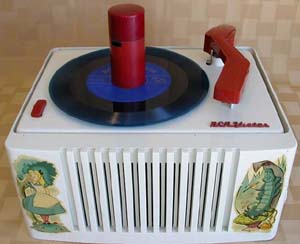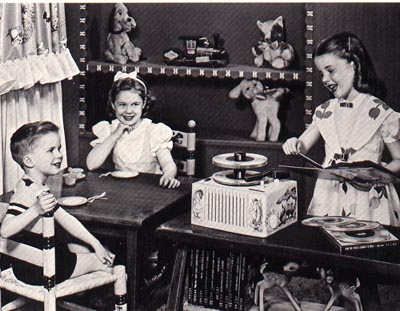

The 45 rpm record player makes the Talking Toy Hall of Fame for its impact on music listening during the 1950's and 60's, particularly by those under 21. In the spring of 1948, Columbia announced the introduction of its new long-playing 33 1/3 rpm records. RCA Victor was caught off guard by this new format but countered very quickly with its new 7 inch vinyl 45 rpm. Thus began the war of speeds. The 45 proved to be successful for children's records and for pop music and its large center holed record became an icon. Playing your stack of 45s at a party is classic Americana. I can remember growing up in the 60's listening to songs on the 45 rpm that our neighbors the Keisters had in their basement just for us kids. I can still hear Johnny and the Hurricanes playing Red River Rock and the Ventures playing Wipeout, over and over and over.
 |
 |
The example chosen for this exhibit is a circa 1954 RCA Victor "Alice in Wonderland" record player. It was one in series of themed children's record players licensed by Walt Disney to RCA. Pictured next to it (above) is a photograph of a children's tea party where this same RCA Victor model is providing the entertainment. My own interpretation of this scene has always been that they are celebrating the birthday of the phongraph. Millions of vinyl 45 rpm records were made until its demise in the 1990's. But as Mark Twain noted in 1897 about the report of his death, the report of the death of the 45 has been exaggerated. For in fact original 45s and special edition re-issues (such as the Restoration Hardware boxed sets of 45s offered in 2004) continue to be sold and played in the 21th century. And for those who grew up with the 45, it's a look and sound that will always be remembered.
The 45rpm record has also left a legacy in language as the "flip side" added a dimension to its meaning of "reverse" or "opposite," referring to playing one side of the record and then turning it over and playing the other side, also known as the B-Side. Each side of a phonograph record was normally labelled as Side A and Side B. The B-Side is normally associated with a "single" and has the connotation of being somewhat less in quality or marketablility than Side A since the hits were placed on Side A. Notice also that 45's were referred to as "singles" even though there were two songs on the record since they each had their own side.